| Shattered
Empire
Picking Up the Pieces in Red Russia
By David Meyler
February 2018
As in its sister games Soldier
Kings, Soldier
Emperor and Indiam Empires, the game pieces
are the graphical highlight of Red
Russia.
Based on period illustrations, the counters
stand out dramatically against the stark
background of the map. I therefore thought
it fitting to give a brief introduction to
the main players in this conflict — a
particularly brutal war in a century of brutality — as
well as some tactical hints for their use
in battle.
Cavalry: The Last Hurrah
Strengths: Movement, intimidation. Just
seeing this unit on top of a stack should
give your opponent pause.
Flaws: You never have enough. High cost
in both manpower and money to build and repair.
Elite Cavalry: 5-2 and 4-2.
The Russian Civil War is one of the last
conflicts where cavalry played its traditional
role as the mobile strike force. The 5-2
is the strongest unit in the game (except
for the Allied 3-2 tank on attack), and only
the Bolshevik gets one after the Red Army
Reforms go into effect. The 4-2 will be the
cutting edge of most offensives. They can
provide a hard-hitting unit for any attack,
while providing the usual cavalry support.
A single elite can also range around sieging
weaker garrison towns (1 and 2) with little
danger of harm. As well, an elite can lead
an all-cavalry army, perhaps the most dangerous
force in the game — fast, strong and
hard to pin down (assuming you have enough
horsemen for such a concentration).
The Reds, with up to nine cavalry, including
two 4-2s as well as the 5-2, have the greatest
cavalry resources. The Southern Whites and
Siberians get only one 4-2 each.
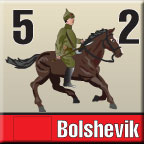 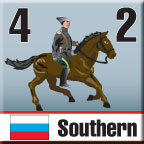
Cavalry First Line: 3-2, 2-2.
The 3-2 is almost as good as a 4-2, and
at least one (or two if you have them) line
cavalry unit should support each main infantry
force. A single cavalry unit will prevent
a pure infantry force from withdrawing, and
likewise, your cavalry can screen the withdrawal
of you army (unless opposed by a superior
force of enemy horse). You can also gang
a stack of 3-2s and 4-2s together with a
good leader to form an all-cavalry army;
very dangerous indeed.
The North/Asian Whites have only four cavalry,
but it will form their best striking force.
A single 2-2 cavalry can act as a mobile
garrison, especially useful to guard a flank.
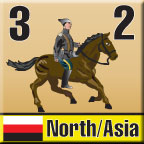 
Cavalry Conscript: 2-1.
Weak on defense, the conscript won’t
last long in combat. As with the 2-2 cavalry,
a single unit makes a good garrison. It will
prevent an enemy from besieging a space you
control unless at least one gold is spent
for a Probe. Backed up by the friendly garrison,
you then have the option of attempting hold
out for one round if the enemy is not too
strong (and if you survive, that single conscript
unit can prevent an enemy siege until next
turn), or if the foe appears in overwhelming
numbers, your cavalry can withdraw (assuming
you have kept a retreat path open). Remember,
an all-cavalry force can always withdraw
regardless of your opponent’s strength
in cavalry.

Infantry: The Proletariat
Goes to War
Strengths: Cheap and plentiful.
Flaws: Slow.
Elite Infantry: 5-2 and 4-2
As with the elite cavalry, only the Reds
have access to the single 5-2 unit, with
up to four 4-2 infantry available. The Southern
and Siberian Whites have only one 4-2 each — and
the Siberian elite represents part of the
Czech Legion, which has this nasty habit
of going home when you can least afford it.
The North/Asian faction doesn’t get
one at all.
 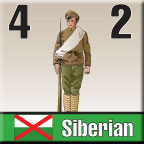
Infantry First Line: 3-2 and 2-2
If the elite provide the cutting edge to
your armies, these guys provide the mass.
If you are not in a hurry, a single 3-2 or
2-2 can be used to besiege weaker or secondary
garrisons. With a defense of 2, they will
not easily take losses (a garrison would
need to roll two 6s, not likely with a 2
point garrison, and impossible once it is
reduced to 1 point), and they will eventually
wear the garrison away.
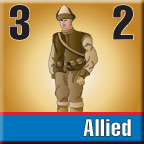 
Infantry Conscript: 2-1
What can you say but “cannon fodder”?
Use them for offense, since they attack as
well as a 2-2, but with a defense of 1 they
won’t last too many rounds of combat.
Use these hapless masses to buffer your better
units. Keep one 2-1 with your air unit (think
air base defense) so it can take a loss first
and maybe spare your precious aircraft.
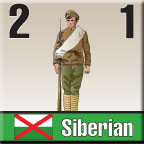
Tanks: A Wrench, a Wrench, My Kingdom for
a Wrench!
Strengths: Attack bonus.
Flaws: Mechanical breakdowns, slow (these
are not the Panther or T-34, boys and girls).
The Bolsheviks have the numbers and dominate
with cavalry, but they fall behind on the
technical side. The Allied 3-2 tank is possibly
the strongest attacking unit in the game.
With the armor bonus on an initial attack,
it has a one-in-three chance of scoring a
hit on a single roll. That gives slightly
better odds of scoring a hit with three rolls
than a 5-strength unit which only scores
a hit on a roll of 6. The problem with Allied
units, though, is getting them to where you
can use them.
The Allies also have a 2-2 tank. The only
other powers to field armor are the Southern
Whites and the Poles, each with a possible
single 2-2 tank. On defense, tanks are no
stronger than infantry. Tanks lack the mobility
of cavalry, and are prone to break down any
time you move them to engage the enemy.
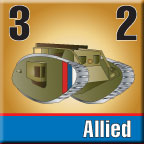 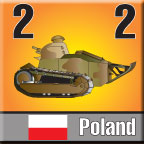
Air Forces: Death or Glory Boys
Strengths: Air strikes.
Flaws: Money, money. Expensive to build,
takes three seasons to build.
Air units get to attack first, as opposed
to most combat which is simultaneous, so
aircraft can theoretically kill an enemy
before he has a chance to strike back. But
air units, like armor, are rare, and they
have only two attacks (a 1/3 chance of scoring
a hit, but only a1/36 chance of scoring double
hits).
The Southern Whites and the Allies have
the two single strongest air units, both
2-2. This is a key unit for the Southerners,
so make sure your air force is where you
will need it. The Siberians and North/Asia
faction can build a 2-1 air (the Red air
force, a single 2-1, cannot appear earlier
than the spring of 1920).
As with all 1-defense units, they will not
last long in prolonged battles, and air fleets
are expensive to repair and even more expensive
to rebuild. Of the minors, only Poland has
an air force, a single 2-1 unit.
 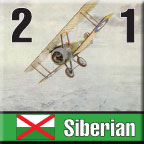
Fleets: Remember the Potemkin
Strengths: You don’t have to build
them.
Flaws: Restricted use, and you can’t
rebuild them once they’re gone.
The Civil War will not be won or lost at
sea. Fleets can be important in taking or
defending an important regional objective
like Sevastopol, but they are overall peripheral.
The biggest advantage is you start with them
on the map.
The Red navy starts with only a 2-1 fleet
at Petrograd (with the optional Black Sea
fleet at Odessa for a second 2-1). The Southern
Whites have a strong 2-2 fleet in the Black
Sea, but the Allies have naval dominance
with fleets along all the coasts. An Allied
fleet is in Murmansk, which can help the
North/Asia Whites.
 
Red
Russia is available now!
|
